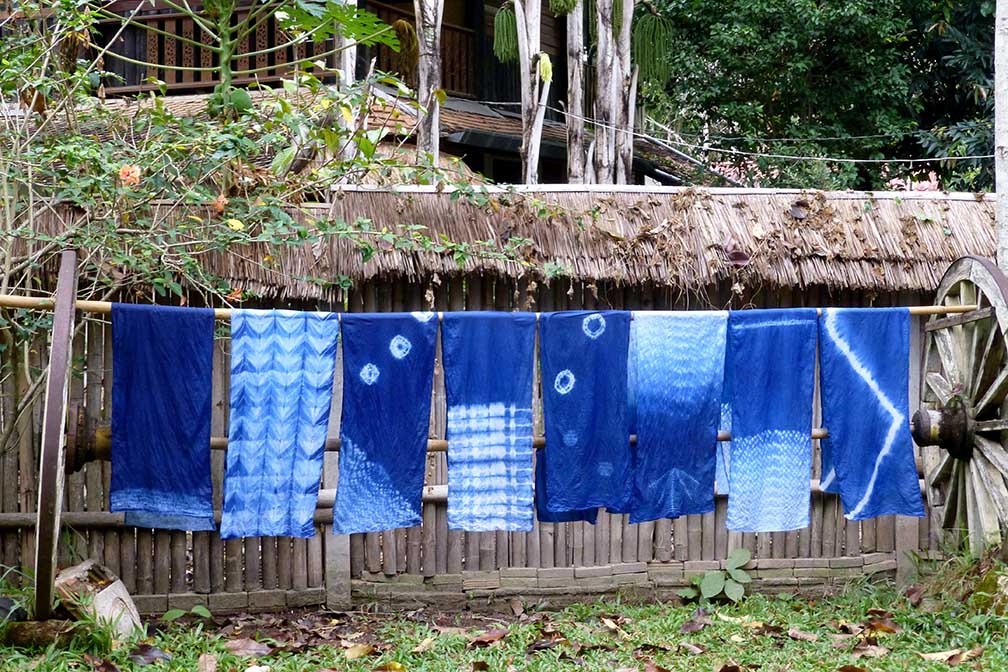In the hazy mist and renowned splendor of Sapa, a traveler
is sure to find beautiful young Hmong girls dressed in charming indigo clothing
even in the most remote areas. Not only are the Hmong good at hemp weaving, they also
utilize a special indigo dyeing technique. As a natural dyeing substance,
indigo is widely used by ethnic minority groups throughout SE Asia. In the
northern mountainous area of Vietnam there are many indigo varieties and each
ethnic minority group is known to use a specific strand of the indigo plant.
The indigo (tsaoz gangz) used by the Hmong in Sapa belongs to wooden stem variety and can be grown in small plots near the house or on the open expanse of fields, and even along fence lines. Generally the soil needs to be plowed once before planting, but if the soil is of poor quality only natural fertilizer is applied. Planted in July or August it can be harvested in April or May.
Indigo dyeing is both time consuming and requires a great deal of patience. In the harvest the best branches are selected to preserve for the next crop. The remaining stems and leaves are soaked in a large wooden vat until the indigo resin dissolves into the water. According to those who know the dyeing process well, what denotes when the resin has been completely dissolved is the water becomes green and clear, sometimes bubbling up after 2-3 days of soaking. The next step is to remove the residue by stirring in a small quantity of lime. When the mixture settles, it is filtered through a thickly woven hemp fabric to make a glue-like substance. This indigo concentrate can be preserved to use for year-round use. To make the dye it is mixed with alcohol and slowly stirred until it bubbles.
However, to ensure a successful dye even the lime must be carefully selected and prepared using both technical experience and superstition passed on for generations. The lime burning technique is unique to the Hmong in Sapa. All steps are carefully followed beginning with the selection of high quality limestone. Next they select hardwood for high temperature burning. Once the fire is ready to ignite, they arrange larger stones on the bottom and smaller on top for ventilation purposes. During this time the participants are not allowed to make love and pregnant women are strictly forbidden to partake in this process. Considered taboo if an accident were to occur, all working tools must not be spoiled with a single drop of blood, even if it is caused by a mosquito bite or a leech.
“To be a successful dye, the vat must have a fresh lively colour. Some people have been known to cry in their heart all their life because they are unable to make indigo properly so their clothes have the colour of an old crow. You can see them at the festivals; they are the ones and who look so sad wearing unpleasant indigo colours.”
In order to attain the desired indigo colour, mugwort (a local medicinal plant) is mixed with ashes for an undisclosed period of time then put in a basket and placed on top of a large wooden vat containing the indigo concentrate mixed with alcohol. Depending on the quantity of fabric to be dyed, spring water is brought from a mountain gorge and filtered through the basket to mix with the concentrate below and stirred thoroughly until it bubbles up. Twice a day the mixture is stirred and covered, once at sunrise and again at sunset. After a few days the indigo vat begins to exude a pleasant fragrance. When the water becomes a clear bubbling yellow, it is ready for dyeing hemp.
Living so close to nature the Hmong have learned over time what it takes to make the perfect vat of indigo dye. For example, in the summer months more water needs to be added to keep the indigo fresh. If it is made in winter, a fire heated stone is put in the middle of the vat to keep it warm. Such expertise may seem primitive to those coming from developed countries, but environmentally friendly processes are increasingly sought after and even trendy as the western world becomes acutely aware of the dangerous toxins, environmental pollution and serious health risks related to industrialization. If for whatever reason a vat of dye doesn’t have the “lively colour” as hoped for, the participants involved in the dyeing process begin to look within themselves. If they find they are in a debt of any kind to the deceased they burn three incense sticks and three hand-made papers to ask the help of their ancestors in paying back their debt. However, if their indigo vat still does not come alive with colour, the vat is believed to be possessed by evils spirits. To exorcise the spirits they make twelve wooden swords darkened with coal and joined together by alang grass. Armed with their spiritual weaponry, a vigil is held around the vat praying for the evil spirits to depart.
When the vat is ready, hemp is dipped into fresh water before dyeing. The wet fabric is carefully positioned in the indigo and left to soak for about an hour. Next the fabric is left to dry and the cycle repeated many times over the course of three or four days if the weather is favorable and sunny. A vital part of this process is dependent on the cooperation of the weather. If the dyeing takes place during the rainy season the process may take upwards of a month to complete. The inherent reward for adhering to ancient dyeing techniques is in the bright indigo colour, the hallmark of the Hmong in Sapa.






